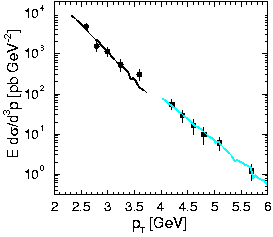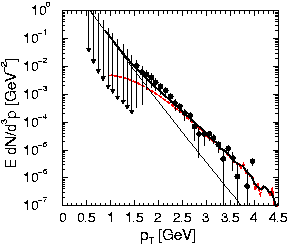|
Recently the WA98 collaboration published data concerning the
direct photon production in the reaction Pb(158 AGeV)+Pb
[1].
Analog to our studies [2] of the dilepton spectra in
similar reactions, we use a superposition of hard photon production
processes and of the yields from thermalized matter in order to
describe these data.
The contributions of the hard annihilation and Compton like diagrams
within the framework of perturbative QCD
are calculated using the event generator PYTHIA.
The comparison of PYTHIA results and various direct photon data in
proton induced collisions indicates that the shapes of the data are
well described.
Fig. 1 displays two examples of the comparison of our calculations and
data.
The hard perturbative QCD contribution, calculated for pp
collisions, is up-scaled such that the large-p^ tail of the
WA98 data is reproduced (cf. fig. 2).
The thermal source is described by
| |
dN
d3p/E
|
= Neff |
5aasTeff2
12p2
|
|
ó
õ
|
1
0
|
ds s2 |
ó
õ
|
+1
-1
|
dx e-A log |
é
ê
ë
|
1+ |
2.912
4pas
|
A |
ù
ú
û
|
|
| (1) |
|
with
A = [(p^coshy (1-sv0x))/(TeffÖ[(1-(sv0)2)])],
an effective temperature of Teff = 170 MeV and
a space-time normalization factor Neff = 3×104 fm4.
These parameters are taken from our analysis [2] of dilepton data.
Contrary to the SPS dilepton data, flow effects are visible in the
photon p^ spectra at values around 2 GeV.
With a maximal radial expansion of v0 = 0.3c of the radiating
fireball a good description of the data is achieved (see fig. 2).

|
|

|
|
Fig. 1 A comparison of calculations of the hard
photon production in proton-proton collisions with data from E704
[3] at Ös = 19.4 GeV (small p^ values) and from UA6 [4]
at Ös = 24.3 GeV (large p^ values).
For more details cf. [5].
|
|
Fig. 2 The data of the WA98 collaboration [1]
compared with the hard direct photons (dashed
curve) and the thermal contribution (thin curve). The sum of these
contributions is depicted by the solid curve.
A radial flow of v0 = 0.3c is assumed.
|
1Institute for Theoretical Physics, 252143 Kiev - 143, Ukraine
References
[1] M. M. Aggarwal et al. (WA98),
Phys. Rev. Lett 85 (2000) 3595
[2] K. Gallmeister, B. Kämpfer, O.P. Pavlenko,
Phys. Lett. 473 (2000) 20
[3] D.L. Adams et al. (E704), Phys. Lett. B 345 (1995) 569
[4] G. Ballocchi et al. (UA6), Phys. Lett. B 317 (1993) 250
[5] K. Gallmeister, B. Kämpfer, O.P. Pavlenko,
Phys. Rev. C 62 (2000) 057901
IKH
06/19/01
© B. Kämpfer
|

